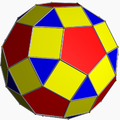- Deltoidal hexecontahedron
-
Deltoidal hexecontahedron 
Click on picture for large version
spinning versionType Catalan Face polygon kite Faces 60 Edges 120 Vertices 62 = 12 + 20 + 30 Face configuration V3.4.5.4 Symmetry group Ih, [5,3]+, 532 Dihedral angle 154° 8' Properties convex, face-transitive 
rhombicosidodecahedron
(dual polyhedron)
NetIn geometry, a deltoidal hexecontahedron (also sometimes called a trapezoidal hexecontahedron, a strombic hexecontahedron, or a tetragonal hexacontahedron) is a catalan solid which looks a bit like an overinflated dodecahedron. It is sometimes also called the trapezoidal hexecontahedron or strombic hexecontahedron. Its dual polyhedron is the rhombicosidodecahedron.
The 60 faces are deltoids or kites (not trapezoidal). The short and long edges of each kite are in the ratio 1.00:1.54.
It is the only Archimedean dual which does not have a Hamiltonian path among its vertices.
See also
References
- Williams, Robert (1979). The Geometrical Foundation of Natural Structure: A Source Book of Design. Dover Publications, Inc. ISBN 0-486-23729-X. (Section 3-9)
- The Symmetries of Things 2008, John H. Conway, Heidi Burgiel, Chaim Goodman-Strass, ISBN 978-1-56881-220-5 [1] (Chapter 21, Naming the Archimedean and Catalan polyhedra and tilings, page 286, tetragonal hexecontahedron)
External links
- Eric W. Weisstein, DeltoidalHexecontahedron and Hamiltonian path (Catalan solid) at MathWorld.
- Deltoidal Hexecontahedron (Trapezoidal Hexecontrahedron) -- Interactive Polyhedron Model
Polyhedron navigator Platonic solids (regular) Archimedean solids
(Semiregular/Uniform)Catalan solids
(Dual semiregular)triakis tetrahedron · rhombic dodecahedron · triakis octahedron · tetrakis cube · deltoidal icositetrahedron · disdyakis dodecahedron · pentagonal icositetrahedron · rhombic triacontahedron · triakis icosahedron · pentakis dodecahedron · deltoidal hexecontahedron · disdyakis triacontahedron · pentagonal hexecontahedronDihedral regular Dihedral uniform Duals of dihedral uniform Dihedral others Degenerate polyhedra are in italics. 
This polyhedron-related article is a stub. You can help Wikipedia by expanding it.
